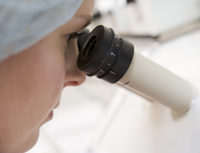In vitro fertilisation
 What is in vitro fertilisation (IVF)?
What is in vitro fertilisation (IVF)?
In Vitro Fertilisation (IVF) is an assisted human reproduction technique in which the woman's oocytes are obtained from ovaries previously stimulated with a hormone treatment and then fertilised in the laboratory with the male partner's sperm to create embryos that, once adequately developed, can either be transferred to the patient's womb or cryopreserved.
IVF is indicated in the following cases:
- Tubal Factor (blocked fallopian tubes)
- Unexplained infertility
- Failure of previous inseminations: infertility of unknown cause
- Severe male factor: abnormal semen
- Genetic alteration requiring preimplantation genetic diagnosis
- Some severe cases of polymicrocystic ovaries
In Vitro Fertilisation (IVF) Stages
1. Stimulation of ovulation
The woman takes hormones to stimulate her ovaries to encourage the production of mature eggs. The ovulation stimulation protocols and medications are adapted to the individual profile of each patient according to the cause of infertility, her hormone profile and her age.
During this process, the patient will have ultrasound scans and blood tests to monitor her progress. This stage usually lasts a maximum of 15 days.
2. Ultrasound-guided ovarian puncture
Once the eggs in the ovaries are mature or "ripe", they are removed to be fertilised in the laboratory. This is performed by an ultrasound-guided follicular puncture.
3. Fertilisation
Once the eggs are in the laboratory, the sperm sample provided by the male partner or, in the case of donor, by the sperm bank, is processed.
There are two fertilisation methods
-
- Traditional insemination, which involves placing a determined number of sperm next to each egg, where fertilisation occurs spontaneously.
- Intracytoplasmic sperm insemination (ICSI): directly injecting sperm into the egg.
In cases where the male partner has had a vasectomy or the semen sample has to be obtained through a testicular sperm extraction (TESE), this is done at the same time as obtaining the eggs so both eggs and semen are available in the lab to proceed with fertilisation.
After fertilisation, the embryos are monitored in the laboratory. Two to three days later they are evaluated and a selection is made for transfer to the patient and/or vitrification.
4. Embryo transfer
The patient will have been on progesterone treatment since the day of the follicular puncture to enhance the potential for the embryo to implant in the womb. She must now go to the assisted reproduction centre where one or two embryos will be placed inside her womb.
After the transfer and until the pregnancy test, which will be done 13 days later, it is advisable not to do strenuous exercise.
What are the chances of success with In Vitro Fertilisation?
The pregnancy rate varies greatly depending on three parameters: the cause of infertility, age and embryo quality.
After having the treatment, can you have sex?
It is not advisable to have sex with penetration in the following few days.
After having the treatment, is it okay to exercise (yoga, pilates, jogging, going to the gym, etc.)?
After the embryo transfer, two days of rest is usually advised and strenuous exercise should be avoided for the first week.
What are the benefits of this procedure in patients with sexually transmitted diseases?
Given the good results in terms of pregnancies, In Vitro Fertilisation is the option with the highest rate of success in couples with sexually transmitted diseases who wish to have children.



















